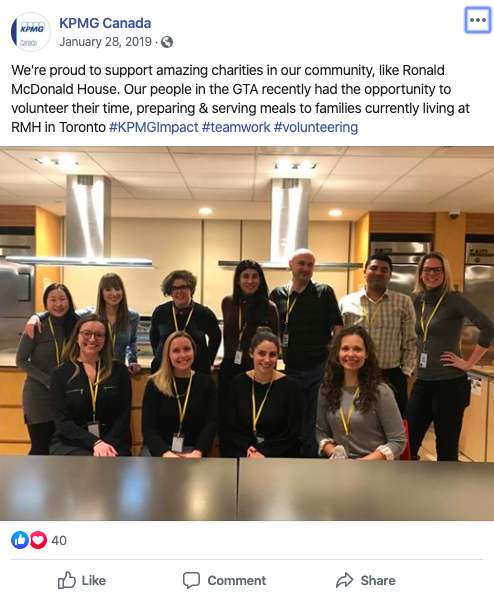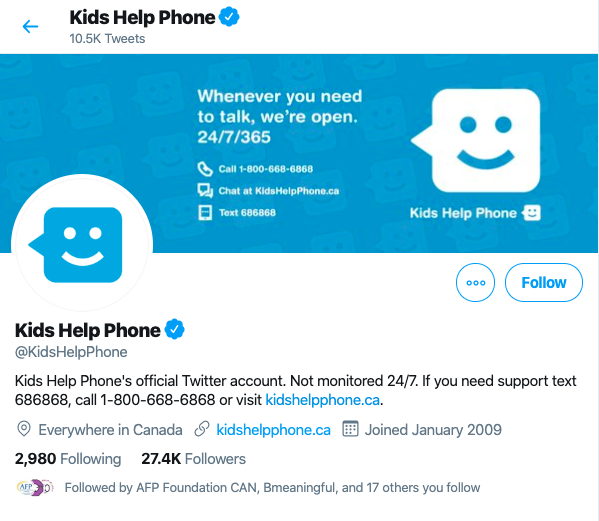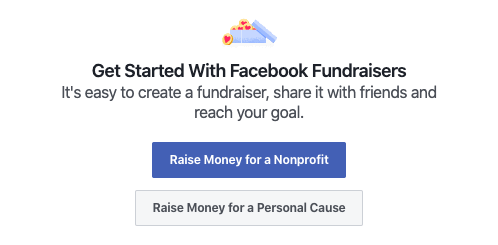February 21, 2020
 by Sayana Izmailova / February 21, 2020
by Sayana Izmailova / February 21, 2020

Over the past decade, social media has become an integral part of our lives.
From staying in touch with friends to growing businesses and communities, it enables us to connect with the world and share or consume information at lightning speed. So what does this mean for your nonprofit organization?
Maybe you already have profiles on all the major platforms – Facebook, Twitter, LinkedIn, Instagram – and are spending so much time trying to get followers that it doesn’t leave much time for your actual goals: fundraising and advancing your cause.
Or maybe you’ve set up your profiles but are too busy to actually post anything or engage with your followers (of which you have 20 and 10 of them are your own staff).
Maybe you keep hearing from everyone around you that your organization needs to be on social media, but you just don’t have the resources. And frankly, you don’t even know where to start.
Regardless of where you are in your social media journey, it’s important to take a step back and assess your situation. This article will allow you to make informed decisions about which of your efforts will lead to the biggest results and help you create a focused plan for success.
The number one question to ask yourself and your staff is: is it worth it?
The truth is, despite everyone telling you that social media is the way of the future and will guarantee your nonprofit’s growth, that’s just not the case. Staying active and engaging with your online community takes a lot of effort, time and resources, so if the nature of how your organization operates doesn’t allow for that, it may be better to focus your efforts somewhere else.
As with any important decision, let’s look at the benefits and the challenges of having a social media presence for your nonprofit. There are many pros and reasons to go ahead with it, if it makes sense for your organization. While there aren’t specific cons, the biggest downfall we see organizations face is spending too much of their time and resources on their social media presence when in reality, they could be seeing much bigger growth and impact if they placed their efforts elsewhere.
In this post, we’ll take a look at the following areas. You can jump ahead to whichever section you need:
Benefits of social media for nonprofitsSocial media has helped millions of businesses, entrepreneurs and yes, even nonprofit organizations. If done right and if your organization is well set up for it, here’s how it could help you:
Social media platforms thrive on the basic human need to share information with each other. When people see something they connect with, they are likely to send it to a friend or family member or repost it on their own profile.
If you’re able to consistently create compelling content that’s likely to be shared across people’s networks, you can reach more people around the world than you ever thought was possible.
Thanks to clever algorithms, social media platforms will even help put your content in front of more eyes if they see that your content is very well received by your existing audience. Plus, you can always invest in paid promotion of your content to help expand your reach.
At the core of any organization is a committed, engaged community of supporters, whether they are followers, donors, volunteers, patrons, members, or just people who connect with the organization’s mission.
Once people have identified themselves as members of your community, it’s imperative to keep them feeling connected and valued. This is done through regular communication: letting them know what your organization has been doing, reporting on your progress, sharing successes and challenges, asking for input, and providing other valuable information.
Social media platforms allow you to do this multiple times a day through updates that you can draft in a matter of minutes. Of course, we recommend having a robust strategy behind your posting rather than drafting whatever comes to mind and sharing it immediately (more on that later), but it is still much faster and more efficient than preparing lengthy newsletters and reports.
Posting updates on social media also allows for two-way communication between your organization and your supporters. People can respond back to you by liking your posts, commenting, or sharing. They can also answer polls and give suggestions and feedback.
Engaged supporters can quickly become ambassadors of your organization by showing their social media networks that they stand behind your cause and encouraging others to join in.
An engaged online community can lead to more real world interactions. Promote your latest fundraising campaign on social media and you will likely get people donating to your cause. Post a link to your next event and you could see some new names on the registration list.
Platforms like Facebook have made it incredibly easy for nonprofit organizations to convert social media followers into supporters with tangible impact. People can make donations to your nonprofit directly through the platform or indicate that they will be attending your event, all while sharing these updates with their networks to inspire even more support.
Your supporters aren’t the only ones on social media. Remember that other organizations, businesses and companies are on there too. Establishing online relationships with organizations whose work is relevant to your mission could be the key to securing your next corporate partner or event sponsor.
If some of your followers work for large corporations, they may even ask their employer if they can take the day off work to volunteer with you or ask about matching their donation to you. It is not uncommon to see an entire department of a corporate company volunteering at a nonprofit event, but these relationships have to start with one passionate supporter who’s willing to get their employer onboard. Who knows, maybe that one supporter finds you through social media.

If you’re passionate about your nonprofit’s work, it must be tied to a greater set of values, and you can use social media to spread the word about these values.
For example, if your nonprofit aims to encourage recycling and lowering waste, you must value protecting the environment and reducing the human impact on Earth. Why not use social media platforms to engage in conversations with other organizations doing similar work? You can promote their work and share their impact with your followers.
Even if their work is different from yours — maybe they work towards reducing wildlife extinction — if you both value protecting the environment, combining your efforts and engaging your two sets of followers in conversation will have much greater impact on your shared mission.
The benefits of social media for your nonprofit are clear, but you won’t be able to reap them without putting in a lot of work, time and resources. Without a proper nonprofit marketing strategy, compelling content and a willingness to constantly course correct, posting all over social media won’t do anything for you except waste your time.
If your nonprofit is serious about having a successful social media presence, you have to be ready to spend considerable time doing the following. First, define your goals. What are you hoping to achieve with your social media presence?
Before you do anything else, answer the following questions.
Keeping these answers in mind will help guide your social media strategy and give a sense of purpose to your work on social platforms. When the going gets tough (and it will get tough), remembering the reasons why this is important to your organization will help you stay motivated to keep at it. It is entirely possible to see something you’ve worked really hard on get close to zero engagement, especially in the early days. This can be discouraging, but remembering your “why” will help you course correct and keep trying.
Your existing community are your primary audience — they are the people you want to engage with and the ones who will help you grow your online following in the long run. Knowing who they are will help you identify the kinds of people you might be able to attract in the future. Try to answer questions about their age range, their interests, and reasons why they were drawn to your organization.
You can also gain insight into your prospective audience by researching similar organizations to yours and looking at who follows them online. How do they interact with the organization’s posts — which posts are they commenting on the most and which are most often shared within their own networks?
Knowing who your audience is can help you get started, but is only one part of the puzzle. You also need to know what exactly they are looking for when it comes to your social media content. You can make assumptions, you can do some trial and error, but you can also just ask them.
One organization was spending tons of time trying to build a following on Twitter, without seeing any results. When they finally decided to send a survey to their donors asking which social platforms they would want to engage with the organization on, they found that only 5% of them chose Twitter. No wonder they were having trouble growing their Twitter presence! They also found that while many of their donors preferred to see posts from them on Facebook, nearly all of their younger donors wished they had an Instagram account instead.
Posting on social media without a proper strategy is like throwing a stack of donation forms into the street on a windy day and hoping someone will mail in a check.
Go back to the goals you’ve identified for your social media presence and think about what rules can be put into place to help you achieve those goals. What kind of content will you post — is it updates about your nonprofit, impact stories, donor spotlights, asks for donations? Will you post any videos? How often will you post each of your selected types of content?
Will you be sharing one-off types of posts or will each of them be tied to a larger campaign? How will these posts help compliment your other marketing or fundraising efforts — your direct mail appeal or your upcoming event.
It’s also important to make sure your social media presence aligns with your organization’s brand. What type of voice will you be using? Are you the type of organization to use GIFs and emojis or will you keep things strictly professional?
Answering all of these questions will you help you plan your posts ahead of time so that you never have to stress over not having any content to post and drafting something last minute for the sake of keeping your followers engaged. Having a strategy and guidelines also comes in handy when more than one person is managing your social media accounts — it keeps the content and voice consistent. Best of all, if your VP ever asks you to post something and you really don’t think it’s a good idea, all you have to do is show them your social media strategy and explain that it just doesn’t align with the rest of your content and your brand.
Finally, having a nonprofit social media strategy will help you clearly see what’s working and what needs to be modified. You can easily track what kinds of posts are getting good engagement so you can implement more of them into your plan.
Metrics will help you stay on track to achieving the goals you’ve established for your social media presence. Even if you have a robust strategy and great engagement, how would you know whether or not your efforts are paying off if you have nothing to measure. Identify some key indicators of success and create goals based on these indicators.
For example, if acquiring new followers is important to your organization’s growth, create a goal like getting 100 new followers per month. Or maybe a big focus of your strategy is creating posts that are shareable, so you’d want to set a target for how many people share each post. Don’t forget to be realistic when setting these goals, especially in the early stages, and adjust them as your following grows overtime.
Maintaining a strong social media presence requires a lot of time. If you’re the only person on your team who will be in charge of social media, plan out how much time you’ll need in order to keep up with your strategy and achieve your goals.
If your main responsibilities take up the majority of your time and leave you with less than one hour per week for social media, it may be a good idea to look into getting help. This can be in the form of delegating some social media related tasks to another member of your team, or even considering investing in software tools or freelancers to help automate some of your tasks. There are plenty of options out there to help with creating, planning, scheduling and posting content.
Your online presence is not only a place for you to engage with your existing community, it’s also a place where you can attract new supporters, educate new audiences about your work and collaborate with other organizations to help advance your shared mission.
You can grow your network by identifying organizations who do similar work or companies who publicly support similar causes, and actively interacting with them on social media. This includes engaging in conversation, sharing their content on your platforms and collaborating to create content that appeals to both of your audiences. It’s a mutually beneficial partnership that will give you exposure to the other organization’s following and help you connect with more people.
One of the best things about popular social media platforms today is that they have built-in analytics to give you insight about how your posts are performing and how your audience engages with you. Take advantage of these tools and track everything you can from the early stages. Analytics will help you test out different strategies and offer a clear indicator of what’s working well and what isn’t. They will help you set relevant metrics for success and identify exactly what you need to change about your tactics in order to reach your goals.
Apart from built-in analytics, it may be a good idea to create your own custom tracking systems, where you can also make note of what you’re doing, when and why you’re doing it and whether or not it’s working. If you’re willing to invest a little bit of money into this, there are also plenty of affordable social media analytics software tools out there to complement your existing analytics toolkit.
By now you hopefully understand that managing a social media presence is not as easy as it may seem. Even if you implement all of the recommendations from the above section — you define your goals and metrics, do your research, have a robust strategy, etc. — it is still entirely possible that your social media efforts don’t pay off and don’t do anything to advance your nonprofit’s work.
Here are some common reasons why we see many nonprofits failing to establish a strong social media presence.
We’ve talked a little bit about establishing a voice and aligning with your brand in the section about strategy, but what’s even more important is staying consistent with it across all your channels. This applies to everything from the language you use, to stylistic choices, your messaging, the quality of photos and videos you post, and even the frequency of your posts.
This is especially important if your nonprofit runs ongoing campaigns. If, for example, your organization works with at-risk youth and you’re in the middle of an appeal specifically to raise money for their arts programming, all of your content across all platforms needs to align with that. The photos, colors, and catch phrases you use to promote this campaign should be the same so that people can get used to seeing them in all communications they receive from you. This will help people understand that this is a priority for your organization and will be the first thing they think about when they think of you.
Now imagine that in the midst of your campaign for arts programming funds, you start posting about the importance of physical activity and promoting a new baseball league initiative you’ll be starting soon. Both areas are equally important to your nonprofit and your community, but suddenly shifting focus can be confusing to your followers and will take their attention away from your campaign for arts programming. You can, of course, promote the baseball league, but it might be worth considering saving this messaging for after the current campaign is finished.
We’ve placed a big focus on strategy and hopefully made it clear that you should be spending a significant amount of time planning out a robust strategy that aligns with your nonprofit’s goals.
However, one of two things tends to happen when people spend a lot of time working on something:
The nature of social media is that it is constantly changing and so your strategy must be flexible enough to change with it, especially if it’s not currently working. The nature of your nonprofit might be evolving too, so your strategy should reflect that. Accepting that the guidelines you've created aren’t set in stone and seeing your strategy as a constant work in progress will help you stay open to opportunities for improvement and growth.
Remember: you’re not posting online to check off an item on your to-do list, you’re doing it as part of accomplishing a bigger goal. So if what you’re doing right now isn’t working for you, go ahead and change it!
Too many organizations are placing all their focus on posting great content. That’s really important, of course, but social media is a two-way conversation.
Imagine that you’ve made a new friend and whenever you get together to talk, they have a lot to say about their life. At first you naturally respond to what they’re saying, make comments, ask questions and give suggestions. But at some point you realize that your friend isn’t actually listening to you — they’re not acknowledging your remarks, aren’t responding to your questions and aren’t taking your suggestions — they just continue talking on and on about their life. Is that a friend you would want around? Probably not.
Your social media interactions should be treated the same way. Think of your community as a group of friends. Engage them in conversation, give them a voice and acknowledge their contributions to the conversation. In social media this translates to liking and responding to comments, asking for suggestions and feedback (and then actually acting on that feedback), following similar organizations and liking, commenting and sharing their posts.
It takes a lot of time, yes, but if you’re not willing to be an active member of your online community, then you might as well not be posting anything at all. You can keep talking, but if your friends don’t feel like they are a part of a two-way conversation, they will quickly lose interest.
This one works exceptionally well with the friendship analogy, too. Imagine that despite feeling excluded from conversations, you gave that new friend another chance. But now another problem becomes evident: your friend talks non-stop about all the great things they’re doing, but none of it actually means anything to you or your life.
A meaningful conversation adds value to your life and is worth your time. The content you share with your community should be educational, entertaining, inspiring or thought provoking. If you’re just posting updates on what your organization has been up to lately, people will quickly realize that there is no reason for them to follow you and will lose interest.
Asking a simple question — what value does this post add to our community? — can help you filter through unengaging content and always have something great to offer your followers.
Speaking of content that adds value, nothing is more inspiring and thought provoking than real life stories. Powerful stories are what connects us all — they elicit emotions, move people to share their experience with others and inspire action.
Let’s compare these two Facebook posts as an example:
Which post did you like better?
The answer is obvious. Couple it with a cute photo of Shyla, sit back, and watch the numbers go up.
Chances are your organization already has tons of stories to share, you just need to know where to find them and how to ask for them. Nonprofits that don’t take advantage of this arsenal of compelling content are missing out on a powerful way to engage with their community and attract new followers.
Now, let’s go back to that friend you’ve been talking to for a minute. They really are the worst. Not only do they only talk about themselves and not add any value to your life, they are constantly asking you for money, too!
There’s nothing attractive about a nonprofit who only posts to remind people to make a donation. There are so many options when it comes to what kind of content to share and we’ve already covered some of it here when talking about best practices: you can share stories of impact, do a spotlight on one of your donors, share something that another organization is doing, provide something educational that relates to your cause, ask for feedback…the list goes on.
Asking for donations too often will deter people from following you. Again, ask yourself what value are you offering to your followers and try to balance valuable content with a few asks here and there.
It’s also entirely possible to incorporate an ask for donations into a different type of post – what’s called a “soft ask” – without explicitly saying “donate now”. Some organizations rely entirely on soft asks and see a lot of success with it. It all depends on the strategy you choose and how it works with the nature of your organization.
When something is well received on social media, it tends to spread like wildfire. In recent years, people have been taking advantage of trends: popular hashtags, challenges, and even just catchy phrases or acronyms (BOGO, FOMO, YOLO, you get the point) – to drive traffic to their profiles. It’s an easy way to get in on a trending conversation and offer your perspective.
Not participating in social media trends, especially if they’re relevant to your organization or the work you’re doing, is like living in a silo. You’re missing out on giving people an excuse to talk about you and re-share your content simply because it’s trendy.
Participating is simple! All you have to do is keep an eye out on what everyone else is doing and then jumping on the bandwagon. When things like the ALS ice bucket challenge and Movember hit the Internet, find ways to incorporate them into your posts. If the challenge is created with a philanthropic cause in mind, you’ll be showing your support and attracting a new online audience all at once.

Now that we’ve considered all the work involved in managing a social media presence for your nonprofit, let’s look at some reasons why all this effort might not actually be worth it for you.
The most obvious reason is that unless you’re willing to actively engage in all of the activities we’ve discussed so far, you won’t see much benefit from being on social media. For many organizations, especially nonprofits, the challenge is that they don’t have enough staff members to allocate time and effort to social media management.
If your organization is growing, maybe start with just one platform instead of making accounts on all of them. You can see what the required time commitment is like and explore the possibility of expanding your online presence to more accounts in the future when you have more staff members. Like we mentioned before, there’s also always the possibility of delegating some social media related tasks to freelancers or automating them with a software tool.
Be realistic about who your audience is and what interests them. Do your research, ask your existing community if they even want to interact with you online. For example, if the majority of your donors are aged 18-49, you will likely find them on Facebook. But what if your nonprofit offers special care for the elderly and most of your donors are the beneficiaries’ children, meaning they are in their 60s and even 70s?
Remember that your existing community is what’s going to help get your social media presence off the ground, so if they’re not online, you’re going to have a hard time growing your audience.
The most basic benefit of social media is that it helps expand your reach and attract new audiences regardless of their geographic location. This works well for national and international organizations because their pool of potential donors is as wide as the range of people they serve. Take Kids Help Phone, a Canadian organization that provides free over-the-phone counselling for children and youth across Canada. They can ask any Canadian to support their cause, so they try to grow their online following as much as possible.
But if your nonprofit’s mission is to preserve the forest area just outside your small city? Is it really reasonable to ask everyone across the country to support your cause? Is it worth your time to grow your social media following to tens of thousands of followers who don’t live in your area or know anything about the forest you’re trying to preserve? In this case, you might be better off adopting a different fundraising approach, such as going to local businesses to ask for sponsorship or more substantial donations.

This is a limitation similar to having your work tied to a geographic location. If your mission is to serve a very niche population, chances are, you will have trouble finding a growing following online.
Growth on social media relies on people with similar interests who share their passions with each other, connect and engage in conversation. This comes easily when you’re talking about topics that are relevant and important to most people, like healthcare, education, the environment, and more.
Say your nonprofit was established by a group of passionate glass beading enthusiasts and offers classes to anyone who is interested. Maybe you’re not even tied to one location and have chapters across the country. The problem still stands — glass beading is exciting, but the vast majority of the general population likely doesn’t care much for it.
Just like the forest conservation organization, you’d have more success partnering with companies in your niche and fundraising from your members’ immediate circles, rather than trying to grow an online following.
If you’ve been fundraising for years and know that you have the most success by building meaningful real world relationships with people in your community, there is no need to reinvent the wheel. For a lot of organizations, online donations make up a small fraction of their fundraising revenue, while the majority comes from direct mail and event registrations, meaning their target audience is just not online and prefers real word interactions.
If that’s the case with your donors as well, putting more focus on social media means you will have less time and resources to do what you already do best. As always, take a close look at your community and how they actually want to interact with you.
Regardless of which way you’re leaning at this point when it comes to social media, it’s not a black and white decision. There are many different platforms, but choosing to start an online presence doesn’t mean you have to be active on all of them.
Perhaps some are better suited for your organization’s needs right now; others might be nice to use later when you have more resources. And there are likely some platforms that you don’t need to ever touch because they just don’t work well with the nature of your nonprofit. Let’s take a quick look at some of the most popular platforms and what they are best suited for.
Facebook is a widely used platform and is great for all types of content. There is no limit to how long posts can be, but because it’s quite oversaturated, people generally don’t like to spend too much time reading updates. For this reason, photos and videos tend to work much better.
Facebook is also very well suited for organizations that have lots of events. It has a separate event module where people can mark themselves as “attending” and share upcoming events with their networks. Finally, Facebook has its own fundraising capabilities, so anyone can raise money from their network to support a cause they feel strongly about.

Twitter has a limit of 280 characters per Tweet, so it’s meant for quick updates or links to the full version of the update. Twitter is the platform where most conversations tend to happen. Anyone can publically direct a Tweet or a reply to any other individual or organization, so it’s all about interacting with followers and peers.
Historically, Twitter has been home to a lot of political, social justice, activism, and pop culture related conversations. Not convinced as to why Twitter is a good platform for your nonprofit? Learn exactly why your nonprofit should be on Twitter and how you can use it to amplify your nonprofit's voice.
LinkedIn is a professional platform — it’s a great place to find and engage with similar organizations, potential sponsors and corporate partners, find volunteers and hire new staff. The type of content posted on LinkedIn is generally educational and related to professional development.
Instagram is primarily used by young people aged 18-24, as well as many businesses and organizations. The focus of the platform is on high quality, impactful images or videos and compelling captions. It’s not great for sharing links because it doesn’t allow links embedded in captions like most other platforms. If you have powerful stories to tell, this is a great platform to share them.
YouTube is the world’s largest platform for video content. It is meant for high quality, well-produced videos of any length, but typically 1-10 minutes long. Growing on YouTube as an organization can be difficult because of oversaturation of content and the platform’s everchanging algorithm, so it’s best suited for housing content that’s shared elsewhere — on other social media platforms, your website, email newsletter, etc.
TikTok is a new video platform for short videos (15-60 seconds long) set to music. It is primarily used by teens, but is rapidly growing in popularity amongst other populations as well. Users frequently participate in challenges and can contribute to a nonprofit cause directly through a challenge.
There are many other social media platforms to choose from, and some are more appropriate for use by nonprofits than others. Popular choices include Pinterest, Snapchat, Reddit, Tumblr, Flickr and Google +. Your best bet is likely to start with one of the bigger ones we’ve discussed above, but dedicate some time to researching whether or not having a presence on these other platforms is worth your time and effort.
The possibilities are endless when it comes to social media, but what it really comes down to is having a robust, well researched plan, as well as a willingness to spend a lot of time adjusting that plan. This article isn’t meant to deter you from getting your nonprofit started on social media — the hope is to help you understand that it can be a lot of work and it’s important to decide now, before you start, whether that work is worth it for you.
We’ve also noted that not every nonprofit needs to be on social media. Depending on what you do, who you serve and whether or not they want to interact with your organization online, you may achieve greater things by focusing your efforts on what you already do best.
Whatever you decide, always remember why you’re doing it and stay open to trying, failing and trying again. Nothing happens overnight, but with a little planning and dedication, you will see your nonprofit grow, whether it is, in fact, on social media or just offline.
Now that you're ready to take the social media world by storm, you'll need to use the right tools to track the success of your nonprofit social media campaigns. Use social media monitoring tools to discover which platforms are reaching your audience and where you need to improve for enhanced engagement across the board.
Sayana Izmailova is the Content Marketing Specialist at Wild Apricot, a membership management software. She has worked at a number of nonprofits and uses her experience to help small organizations advance their missions.
Across generations, class divides, and national borders, social media brings us together and...
 by Rodney Laws
by Rodney Laws
Implementing a social media marketing strategy can seem like an impossible task for a small...
 by Stephanie Graham
by Stephanie Graham
Organization is at the core of a strong social media strategy.
 by Alexa Drake
by Alexa Drake
Across generations, class divides, and national borders, social media brings us together and...
 by Rodney Laws
by Rodney Laws
Implementing a social media marketing strategy can seem like an impossible task for a small...
 by Stephanie Graham
by Stephanie Graham


